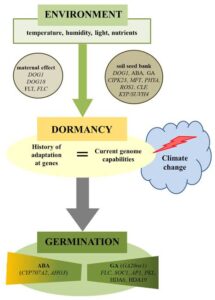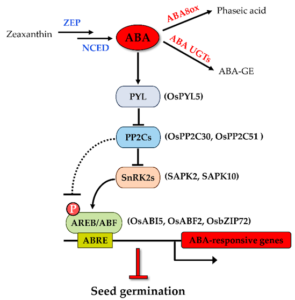Back to: Botany 200 Level
Hello, brilliant learner! Have you ever planted seeds and wondered why some sprout quickly while others take weeks or even months? Or why certain seeds refuse to grow until the rainy season starts? The secret behind this lies in hormonal control of seed dormancy and germination.
Today, we’ll learn how plant hormones regulate when a seed should stay dormant (inactive) and when it should start germinating (growing into a seedling).
Hormonal control of seed dormancy and germination
What Is Seed Dormancy and Germination?
Seed dormancy is when a seed remains inactive and does not grow, even if conditions seem suitable. This helps seeds survive harsh conditions like drought or extreme temperatures.
Germination happens when a dormant seed starts growing into a seedling under the right conditions—water, oxygen, and warmth.
Several plant hormones work together to control these processes, but the two most important ones are:

✅ Abscisic acid (ABA) – Keeps seeds dormant.
✅ Gibberellins (GA) – Break dormancy and start germination.
Let’s break down their roles.
1. Abscisic Acid (ABA) – The Dormancy Hormone
ABA is known as the “sleep hormone” of plants. It prevents seeds from germinating too early by keeping them in a dormant state. This is important because if a seed sprouts at the wrong time, like during dry season, it may die from lack of water.
How Does ABA Maintain Seed Dormancy?
It blocks enzymes that break down food stored in the seed.
It prevents water absorption, stopping the seed from swelling and sprouting.
It keeps the embryo inactive until conditions improve.
✅ Example: Some Nigerian crops like millet and sorghum have high ABA levels, preventing them from germinating until the rainy season starts.

2. Gibberellins (GA) – The Germination Hormone
When conditions are favourable (enough water, oxygen, and warmth), gibberellins take over. They act as a “wake-up call” for the seed, breaking dormancy and triggering germination.
How Do Gibberellins Promote Germination?
They break down ABA, allowing the seed to absorb water.
They activate enzymes that convert stored starch into sugar for energy.
They stimulate cell division and growth, causing the seedling to emerge.
✅ Example: Farmers sometimes spray gibberellins on rice or wheat seeds to speed up germination.
How Do ABA and GA Work Together?
When a seed is dormant, ABA levels are high, and GA levels are low.
When the seed is ready to germinate, ABA levels drop, and GA levels increase.
The balance between these two hormones determines when a seed will sprout.
✅ Think about it like a seesaw: If ABA is high, the seed stays dormant. If GA is high, the seed starts growing.
Why Is Hormonal Control of Seeds Important?
✔ Prevents seeds from germinating at the wrong time.
✔ Ensures seeds survive harsh weather conditions.
✔ Helps farmers control crop germination for better yield.
✔ Allows seeds to wait until they have enough water and nutrients.
Summary
Seed dormancy is controlled by abscisic acid (ABA), which keeps the seed inactive.
Germination is triggered by gibberellins (GA), which break dormancy and promote growth.
The balance between ABA and GA determines when a seed will sprout.
Farmers use this knowledge to improve crop production and store seeds safely.
Let’s Test Your Understanding:
- What is the role of ABA in seed dormancy?
- How do gibberellins help seeds germinate?
- Why is it important for seeds to remain dormant in harsh conditions?
Great job, superstar! Now you understand how hormones control when seeds sleep and when they wake up. Keep learning, and see you in the next lesson!
